Soyuz 31
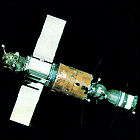 The Soviet Union’s Soyuz 31 mission to the Salyut 6 space station lifts off, with cosmonauts Valery Bykovsky and Sigmund Jahn (the first East German space traveler) aboard. The crews are segregated less than on previous Interkosmos flights, and the Soyuz 31 crew is in space for over a week. They leave their vehicle at Salyut 6 and return in the Soyuz 29 vehicle on September 3rd.
The Soviet Union’s Soyuz 31 mission to the Salyut 6 space station lifts off, with cosmonauts Valery Bykovsky and Sigmund Jahn (the first East German space traveler) aboard. The crews are segregated less than on previous Interkosmos flights, and the Soyuz 31 crew is in space for over a week. They leave their vehicle at Salyut 6 and return in the Soyuz 29 vehicle on September 3rd.
Soyuz 30
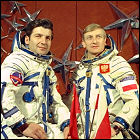 Soyuz 30 lifts off en route to a brief visit with the crew of space station Salyut 6. This is the second manned Interkosmos mission, with cosmonaut Pyotr Klimuk and the first Polish cosmonaut, Mirosław Hermaszewski, aboard. They dock at Salyut 6 after two days in orbit, and spend a total of eight days in space. Though some joint experiments are conducted among the four occupants of the station, the Soyuz 30 crew frequently has to perform experiments in its own Soyuz vehicle to avoid getting in the station crew’s way, and the mission is kept short to free up the second docking port for a Progress unmanned supply vehicle launched four days after Soyuz 30 returns to Earth.
Soyuz 30 lifts off en route to a brief visit with the crew of space station Salyut 6. This is the second manned Interkosmos mission, with cosmonaut Pyotr Klimuk and the first Polish cosmonaut, Mirosław Hermaszewski, aboard. They dock at Salyut 6 after two days in orbit, and spend a total of eight days in space. Though some joint experiments are conducted among the four occupants of the station, the Soyuz 30 crew frequently has to perform experiments in its own Soyuz vehicle to avoid getting in the station crew’s way, and the mission is kept short to free up the second docking port for a Progress unmanned supply vehicle launched four days after Soyuz 30 returns to Earth.
Soyuz 29
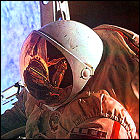 The Soviet Union launches Soyuz 29 on a mission to berth at space station Salyut 6 for a period of around four months. Cosmonauts Vladimir Kovalyonok and Aleksandr Ivanchenkov are aboard, and they eventually set a new space endurance record, remaining in orbit for 139 days. Numerous material science experiments are carried out, as well as a spacewalk to retrieve samples of various materials left exposed to space outside the station. The crew is also assigned to take on a more rigorous exercise program. They will return to Earth in November after swapping vehicles with the crew of Soyuz 31.
The Soviet Union launches Soyuz 29 on a mission to berth at space station Salyut 6 for a period of around four months. Cosmonauts Vladimir Kovalyonok and Aleksandr Ivanchenkov are aboard, and they eventually set a new space endurance record, remaining in orbit for 139 days. Numerous material science experiments are carried out, as well as a spacewalk to retrieve samples of various materials left exposed to space outside the station. The crew is also assigned to take on a more rigorous exercise program. They will return to Earth in November after swapping vehicles with the crew of Soyuz 31.
Soyuz 28
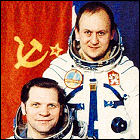 The Soviet Union launches the Soyuz 28 mission, the first manned flight in its Interkosmos series of international space missions. Cosmonaut Vladimír Remek is the first Czech in space, as well as the first space traveler not born in the Soviet Union or the United States; along with Soyuz 28 mission commander Alexei Gubarev, Remek visits the Salyut 6 space station for several days, though is presence is purely political showmanship; Remek later reveals that he had few actual functions to perform during the flight. Soyuz 28 spends a total of nearly eight days in space before returning to Earth.
The Soviet Union launches the Soyuz 28 mission, the first manned flight in its Interkosmos series of international space missions. Cosmonaut Vladimír Remek is the first Czech in space, as well as the first space traveler not born in the Soviet Union or the United States; along with Soyuz 28 mission commander Alexei Gubarev, Remek visits the Salyut 6 space station for several days, though is presence is purely political showmanship; Remek later reveals that he had few actual functions to perform during the flight. Soyuz 28 spends a total of nearly eight days in space before returning to Earth.
Progress 1
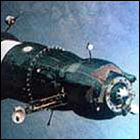 The first Soviet-made uncrewed Progress resupply vehicle lifts off en route to the manned Salyut 6 space station. Looking more or less like a Soyuz vehicle, Progress is an automated freighter whose systems lock onto Salyut’s docking transponder, guiding the unmanned craft toward a smooth and completely automated docking (though ground controllers stand by to take manual control by remote). Since Progress is not required to return a crew to Earth, its engines and their fuel can help to boost Salyut 6 into a higher orbit when necessary. It carries over 5,000 pounds of food, clothes and other supplies, and can automatically refill the station’s air and fuel supplies. Progress vehicles become an integral part of the space program, remaining in service long enough to resupply the International Space Station in the 21st century.
The first Soviet-made uncrewed Progress resupply vehicle lifts off en route to the manned Salyut 6 space station. Looking more or less like a Soyuz vehicle, Progress is an automated freighter whose systems lock onto Salyut’s docking transponder, guiding the unmanned craft toward a smooth and completely automated docking (though ground controllers stand by to take manual control by remote). Since Progress is not required to return a crew to Earth, its engines and their fuel can help to boost Salyut 6 into a higher orbit when necessary. It carries over 5,000 pounds of food, clothes and other supplies, and can automatically refill the station’s air and fuel supplies. Progress vehicles become an integral part of the space program, remaining in service long enough to resupply the International Space Station in the 21st century.
Soyuz 27
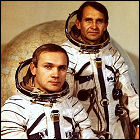 The Soviet Union launches Soyuz 27 on a mission to the Salyut 6 space station – the first instance of three vehicles being docked together in space. Cosmonauts Vladimir Dzhanibekov and Oleg Makarov spend six days with the crew of Soyuz 26 board the station, although Dzhanibekov and Makarov swap capsules with the station crew, leaving the newer vehicle at the station for their eventual return. The crew of Soyuz 27 is in space for less than a week, but their spacecraft remains in orbit, connected to Salyut, for over two months.
The Soviet Union launches Soyuz 27 on a mission to the Salyut 6 space station – the first instance of three vehicles being docked together in space. Cosmonauts Vladimir Dzhanibekov and Oleg Makarov spend six days with the crew of Soyuz 26 board the station, although Dzhanibekov and Makarov swap capsules with the station crew, leaving the newer vehicle at the station for their eventual return. The crew of Soyuz 27 is in space for less than a week, but their spacecraft remains in orbit, connected to Salyut, for over two months.
Soyuz 26
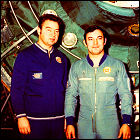 A two-man crew – cosmonauts Yuri Romanenko and Georgi Grechko – is launched aboard Soyuz 26 by the Soviet Union. The Soyuz capsule docks with the recently-launched Salyut 6 space station, and the crew takes up residence for over three months, setting a new space endurance record at 96 days. The Soyuz 27 crew visits in January and swaps vehicles with the station occupants, meaning that Romanenko and Grechko technically return to Earth aboard Soyuz 27 in March 1978. Ten days into the mission, the first Soviet spacewalk since 1969 is undertaken to examine the forward docking hatch of Salyut 6, with which the previous mission failed to connect. This spacewalk was the first outing of the Soviet-made Orlan spacesuit, a design still in use on the International Space Station in the 21st century.
A two-man crew – cosmonauts Yuri Romanenko and Georgi Grechko – is launched aboard Soyuz 26 by the Soviet Union. The Soyuz capsule docks with the recently-launched Salyut 6 space station, and the crew takes up residence for over three months, setting a new space endurance record at 96 days. The Soyuz 27 crew visits in January and swaps vehicles with the station occupants, meaning that Romanenko and Grechko technically return to Earth aboard Soyuz 27 in March 1978. Ten days into the mission, the first Soviet spacewalk since 1969 is undertaken to examine the forward docking hatch of Salyut 6, with which the previous mission failed to connect. This spacewalk was the first outing of the Soviet-made Orlan spacesuit, a design still in use on the International Space Station in the 21st century.
Saving Skylab?
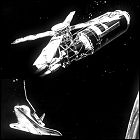 NASA and its contractors mull over a report outlining an ambitious (and, considering the continuous delays to the first launch of the Space Shuttle program, overly optimistic) plan to reactivate and occupy the Apollo-era space station Skylab for use by shuttle crews. The plan involves outfitting the ailing station with new solar power panels and equipment, and performing repairs to make it habitable for future astronauts. Despite the best-laid plans, however, the shuttle’s first launch comes after Skylab tumbles back through Earth’s atmosphere.
NASA and its contractors mull over a report outlining an ambitious (and, considering the continuous delays to the first launch of the Space Shuttle program, overly optimistic) plan to reactivate and occupy the Apollo-era space station Skylab for use by shuttle crews. The plan involves outfitting the ailing station with new solar power panels and equipment, and performing repairs to make it habitable for future astronauts. Despite the best-laid plans, however, the shuttle’s first launch comes after Skylab tumbles back through Earth’s atmosphere.
Enterprise Approach & Landing Test 5
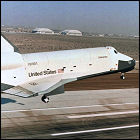 Astronauts Fred Haise and Gordon Fullerton bring Space Shuttle Enterprise back to the ground safely for its fifth free-flight landing test, the second to land with the shuttle’s engines exposed and the first to land on an actual paved runway at Edwards Air Force Base. The crew successfully compensates for a “bouncing” problem experienced on previous shuttle test landings, proving that Enterprise’s sister ships should be able to land safely after returning from orbit. Following this test, Enterprise is slated to undergo a major refit to finish it out into a spaceworthy orbiter, but NASA ultimately decides the process is too expensive. This is the final free-flight of Space Shuttle Enterprise.
Astronauts Fred Haise and Gordon Fullerton bring Space Shuttle Enterprise back to the ground safely for its fifth free-flight landing test, the second to land with the shuttle’s engines exposed and the first to land on an actual paved runway at Edwards Air Force Base. The crew successfully compensates for a “bouncing” problem experienced on previous shuttle test landings, proving that Enterprise’s sister ships should be able to land safely after returning from orbit. Following this test, Enterprise is slated to undergo a major refit to finish it out into a spaceworthy orbiter, but NASA ultimately decides the process is too expensive. This is the final free-flight of Space Shuttle Enterprise.
The Space Shuttle’s ambitious schedule
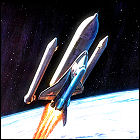 NASA prepares a preliminary schedule of Space Shuttle launches, covering the years 1979-1982 (and assuming the shuttle will be ready to launch in 1979). The ambitious schedule (which also assumes, in line with current planning, that the test orbiter Enterprise will be upgraded to spaceworthiness) includes almost-monthly flights from 1979 onward to deploy communications and weather satellites already on the drawing board, as well as frequent science missions with the cargo-bay-mounted Spacelab. On only the second test flight, the schedule has OV-102 (yet to be named Columbia) slated for a mission to the abandoned early 1970s space station Skylab, using a teleoperator retrieval system which also exists only on paper. While many of the schedule’s goals will be met, the delay in the shuttle program will be longer than NASA anticipates at this time.
NASA prepares a preliminary schedule of Space Shuttle launches, covering the years 1979-1982 (and assuming the shuttle will be ready to launch in 1979). The ambitious schedule (which also assumes, in line with current planning, that the test orbiter Enterprise will be upgraded to spaceworthiness) includes almost-monthly flights from 1979 onward to deploy communications and weather satellites already on the drawing board, as well as frequent science missions with the cargo-bay-mounted Spacelab. On only the second test flight, the schedule has OV-102 (yet to be named Columbia) slated for a mission to the abandoned early 1970s space station Skylab, using a teleoperator retrieval system which also exists only on paper. While many of the schedule’s goals will be met, the delay in the shuttle program will be longer than NASA anticipates at this time.
Enterprise Approach & Landing Test 4
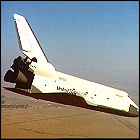 Space Shuttle Enterprise makes its fourth free-flight after separating from its modified Boeing 747 carrier aircraft, gliding to a safe landing at Edwards Air Force Base’s dry lake bed runway. For the first time, Enterprise’s engines are left exposed, adding to the drag experienced by the gliding shuttle rather than masking the engines with a protective cover. This more accurately simulates the aerodynamics of a shuttle returning from space. Enterprise’s crew for the two-and-a-half-minute flight consists of Joe Engle and Richard Truly.
Space Shuttle Enterprise makes its fourth free-flight after separating from its modified Boeing 747 carrier aircraft, gliding to a safe landing at Edwards Air Force Base’s dry lake bed runway. For the first time, Enterprise’s engines are left exposed, adding to the drag experienced by the gliding shuttle rather than masking the engines with a protective cover. This more accurately simulates the aerodynamics of a shuttle returning from space. Enterprise’s crew for the two-and-a-half-minute flight consists of Joe Engle and Richard Truly.
Soyuz 25
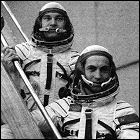 The Soviet Union launches Soyuz 25 into Earth orbit, with cosmonauts Vladimir Kovalyonok and Valery Ryumin set to become the first occupants of the new Salyut 6 space station. However, the crew is unable to successfully dock Soyuz 25 to Salyut 6, and after a fifth attempt to dock, the mission is aborted and the cosmonauts are recalled to Earth due to concerns about the remaining fuel in their vehicle. As a result, Soyuz 25 is the last all-rookie Soviet space crew until the 1990s.
The Soviet Union launches Soyuz 25 into Earth orbit, with cosmonauts Vladimir Kovalyonok and Valery Ryumin set to become the first occupants of the new Salyut 6 space station. However, the crew is unable to successfully dock Soyuz 25 to Salyut 6, and after a fifth attempt to dock, the mission is aborted and the cosmonauts are recalled to Earth due to concerns about the remaining fuel in their vehicle. As a result, Soyuz 25 is the last all-rookie Soviet space crew until the 1990s.
Salyut 6
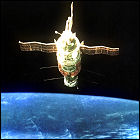 The Soviet Union launches the redesigned Salyut 6 space station, which will remain in service for five years. With six years of experience in building and operating space stations, Soviet space engineers embark on a rethink of station construction, opting for a more modular approach with Salyut 6: the new station has docking ports fore and aft, with additional station modules and automated resupply vehicles already on the drawing board. The dual docking ports also allow for multiple Soyuz capsules to be berthed at Salyut 6, making larger crews possible.
The Soviet Union launches the redesigned Salyut 6 space station, which will remain in service for five years. With six years of experience in building and operating space stations, Soviet space engineers embark on a rethink of station construction, opting for a more modular approach with Salyut 6: the new station has docking ports fore and aft, with additional station modules and automated resupply vehicles already on the drawing board. The dual docking ports also allow for multiple Soyuz capsules to be berthed at Salyut 6, making larger crews possible.
Enterprise Approach & Landing Test 3
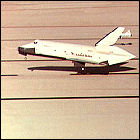 For the third time, Space Shuttle Enterprise separates from the back of a Boeing 747 flying at nearly 25,000 feet above the dry lake bed landing strips at Edwards Air Force Base in California. With astronauts Fred Haise and Gordon Fullerton aboard, Enterprise safely glides to her third safe landing at Edwards. This is the last of the test landings to leave the aerodynamic tail cone over Enterprise’s “anatomically correct” (but nonfunctional) main engines; the remaining Approach & Landing test flights will test the aerodynamics of an orbiter as it would return from space with those engines exposed.
For the third time, Space Shuttle Enterprise separates from the back of a Boeing 747 flying at nearly 25,000 feet above the dry lake bed landing strips at Edwards Air Force Base in California. With astronauts Fred Haise and Gordon Fullerton aboard, Enterprise safely glides to her third safe landing at Edwards. This is the last of the test landings to leave the aerodynamic tail cone over Enterprise’s “anatomically correct” (but nonfunctional) main engines; the remaining Approach & Landing test flights will test the aerodynamics of an orbiter as it would return from space with those engines exposed.
Enterprise Approach & Landing Test 2
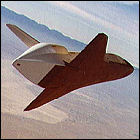 For the second time, the Space Shuttle Enterprise makes a safe landing at Edwards Air Force base after being released from the back of NASA’s 747 Shuttle Carrier Aircraft at the higher altitude of 26,000 feet over the Mojave Desert. Again testing the shuttle’s glide-only landing method, Enterprise has no engines to keep it aloft and glides to a successful landing.
For the second time, the Space Shuttle Enterprise makes a safe landing at Edwards Air Force base after being released from the back of NASA’s 747 Shuttle Carrier Aircraft at the higher altitude of 26,000 feet over the Mojave Desert. Again testing the shuttle’s glide-only landing method, Enterprise has no engines to keep it aloft and glides to a successful landing.
Space Shuttle external tank
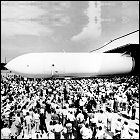 The first Space Shuttle external tank, given the designation MPTA-ET (main propulsion test article external tank), is completed at NASA’a Michoud assembly plant in New Orleans. Though constructed to flight specifications (as they stand in 1977), MPTA-ET is not intended for orbital flight, but is instead erected on a test firing stand at a NASA facility in Mississippi for tests of the three-engine shuttle propulsion system, tests which do not produce a satisfactory result until July 1980. Its job completed, MPTA-ET is later put on display at the U.S. Space & Rocket Center in Huntsville, Alabama.
The first Space Shuttle external tank, given the designation MPTA-ET (main propulsion test article external tank), is completed at NASA’a Michoud assembly plant in New Orleans. Though constructed to flight specifications (as they stand in 1977), MPTA-ET is not intended for orbital flight, but is instead erected on a test firing stand at a NASA facility in Mississippi for tests of the three-engine shuttle propulsion system, tests which do not produce a satisfactory result until July 1980. Its job completed, MPTA-ET is later put on display at the U.S. Space & Rocket Center in Huntsville, Alabama.
Enterprise Approach & Landing Test 1
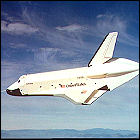 Released from its 747 Shuttle Carrier Aircraft in mid-air for the first time, and airborne on its own for the first time, the Space Shuttle Enterprise takes wing over the dry lake bed at Edwards Air Force Base for a test landing. With no engines on board (a test shuttle that will never go into orbit, Enterprise isn’t equipped with them) and only one shot at a safe landing, Enterprise successfully touches down on the runway after a flight lasting only a few minutes, validating the unpowered approach method of landing a shuttle just returned from space.
Released from its 747 Shuttle Carrier Aircraft in mid-air for the first time, and airborne on its own for the first time, the Space Shuttle Enterprise takes wing over the dry lake bed at Edwards Air Force Base for a test landing. With no engines on board (a test shuttle that will never go into orbit, Enterprise isn’t equipped with them) and only one shot at a safe landing, Enterprise successfully touches down on the runway after a flight lasting only a few minutes, validating the unpowered approach method of landing a shuttle just returned from space.
Salyut 5 burns up
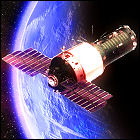 The Soviet-launched Salyut 5 military space station tumbles out of its orbit, having exhausted the fuel needed to keep it in a controlled orbit of the Earth. The two-ton space station burns up on re-entry, having been visited by only two crews; another mission to Salyut 5 had been planned, but its fuel depletion made that flight too risky to undertake.
The Soviet-launched Salyut 5 military space station tumbles out of its orbit, having exhausted the fuel needed to keep it in a controlled orbit of the Earth. The two-ton space station burns up on re-entry, having been visited by only two crews; another mission to Salyut 5 had been planned, but its fuel depletion made that flight too risky to undertake.
Enterprise goes around the block again
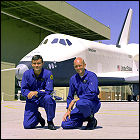 Space Shuttle Enterprise takes off – on the back of a Boeing 747 – for the last of its “active-captive” flights, with a crew aboard and all systems powered up. For this final test flight prior to the first free-flight landing test mere weeks away, Enterprise is again crewed by astronauts Fred Haise and Gordon Fullerton, and reaches an altitude of 30,000 feet.
Space Shuttle Enterprise takes off – on the back of a Boeing 747 – for the last of its “active-captive” flights, with a crew aboard and all systems powered up. For this final test flight prior to the first free-flight landing test mere weeks away, Enterprise is again crewed by astronauts Fred Haise and Gordon Fullerton, and reaches an altitude of 30,000 feet.
Enterprise takes to the sky again
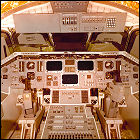 Riding the back of a modified Boeing 747, Space Shuttle Enterprise ascends to 22,000 feet for her second “active-captive” test flight, with all systems powered up and a crew aboard (astronauts Joe Engle and Richard Truly). The combined vehicle reaches speeds of over 300 miles per hour, and angles for “dropoff” – for upcoming test flights in which the Enterprise will actually separate from the 747 and glide to its landing strip – are studied for future reference.
Riding the back of a modified Boeing 747, Space Shuttle Enterprise ascends to 22,000 feet for her second “active-captive” test flight, with all systems powered up and a crew aboard (astronauts Joe Engle and Richard Truly). The combined vehicle reaches speeds of over 300 miles per hour, and angles for “dropoff” – for upcoming test flights in which the Enterprise will actually separate from the 747 and glide to its landing strip – are studied for future reference.
Enterprise takes another test drive
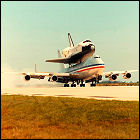 Mounted on the back of Boeing 747, the Space Shuttle Enterprise takes off on its first crewed flight, the first of three “captive-active” flights which see Enterprise remain in place on its carrier aircraft. For the first time, Enterprise’s computers, avionics and other flight systems are powered up in a full-up, hour-long dress rehearsal of an eventual free-flight landing test at 15,000 feet. The first crew of the Space Shuttle Enterprise consists of astronauts Fred Haise and Gordon Fullerton.
Mounted on the back of Boeing 747, the Space Shuttle Enterprise takes off on its first crewed flight, the first of three “captive-active” flights which see Enterprise remain in place on its carrier aircraft. For the first time, Enterprise’s computers, avionics and other flight systems are powered up in a full-up, hour-long dress rehearsal of an eventual free-flight landing test at 15,000 feet. The first crew of the Space Shuttle Enterprise consists of astronauts Fred Haise and Gordon Fullerton.
Space Cooperation Agreement renewed
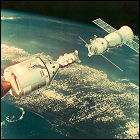 With the 1972 agreement having resulted in the successful Apollo-Soyuz Test Project, the United States and the Soviet Union formally renew the Space Cooperation Agreement. As an immediate goal to build on Apollo-Soyuz, both countries hold tentative discussions about docking the American Space Shuttle (which, it is still assumed, will be in space before the 1970s are out) and a Soviet Salyut space station. Though the shuttle’s first flight is still being delayed, the biggest hurdle will prove to be international relations, specifically a renewed chilling of the Cold War thanks to the Soviet Union’s 1979 invasion of Afghanistan.
With the 1972 agreement having resulted in the successful Apollo-Soyuz Test Project, the United States and the Soviet Union formally renew the Space Cooperation Agreement. As an immediate goal to build on Apollo-Soyuz, both countries hold tentative discussions about docking the American Space Shuttle (which, it is still assumed, will be in space before the 1970s are out) and a Soviet Salyut space station. Though the shuttle’s first flight is still being delayed, the biggest hurdle will prove to be international relations, specifically a renewed chilling of the Cold War thanks to the Soviet Union’s 1979 invasion of Afghanistan.
Enterprise test drive
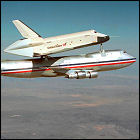 Mated to its Boeing 747 Shuttle Carrier Aircraft, Space Shuttle Enterprise goes airborne for the first time in the first of a series of “captive-inert” test flights. During these flights, there is no crew aboard Enterprise, nor are any of the test shuttle’s systems powered up; the flights are intended to make sure that the combination of the 747 and the Enterprise is capable of being flown safely. Further “captive-inert” flights are carried out over a ten-day period.
Mated to its Boeing 747 Shuttle Carrier Aircraft, Space Shuttle Enterprise goes airborne for the first time in the first of a series of “captive-inert” test flights. During these flights, there is no crew aboard Enterprise, nor are any of the test shuttle’s systems powered up; the flights are intended to make sure that the combination of the 747 and the Enterprise is capable of being flown safely. Further “captive-inert” flights are carried out over a ten-day period.
Enterprise hails a taxi
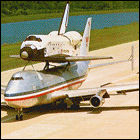 Space Shuttle Enterprise, mated to the heavily-modified Boeing 747 Shuttle Carrier Aircraft (SCA) for the first time, undergoes three “taxi tests” to enusre the structural stability of the two-vehicle combination on the runway before they ever take off. This is the first phase of a series of tests that will culminate, later in 1977, in a series of brief unpowered flights and landing tests using the Enterprise, verifying the shuttle’s gliding aerodynamics.
Space Shuttle Enterprise, mated to the heavily-modified Boeing 747 Shuttle Carrier Aircraft (SCA) for the first time, undergoes three “taxi tests” to enusre the structural stability of the two-vehicle combination on the runway before they ever take off. This is the first phase of a series of tests that will culminate, later in 1977, in a series of brief unpowered flights and landing tests using the Enterprise, verifying the shuttle’s gliding aerodynamics.
Soyuz 24
 The Soviet Union launches the Soyuz 24 mission to the Salyut 5 military space station. Cosmonauts Viktor Gorbatko and Yuri Glazkov carry special breathing gear to protect them from toxic fumes reported to have been the cause of the hasty exit of the crew of Soyuz 21 in 1976. They vent the entire atmosphere of Salyut 5 into space and replenish it, taking up residence for 18 days, during which they perform their own science and Earth surveillance experiments. They leave the station habitable for a visit by another crew, but Salyut 5’s fuel will be exhausted before that mission can take place.
The Soviet Union launches the Soyuz 24 mission to the Salyut 5 military space station. Cosmonauts Viktor Gorbatko and Yuri Glazkov carry special breathing gear to protect them from toxic fumes reported to have been the cause of the hasty exit of the crew of Soyuz 21 in 1976. They vent the entire atmosphere of Salyut 5 into space and replenish it, taking up residence for 18 days, during which they perform their own science and Earth surveillance experiments. They leave the station habitable for a visit by another crew, but Salyut 5’s fuel will be exhausted before that mission can take place.
Soyuz 23: Soviet surprise splashdown!
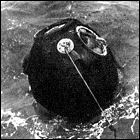 The Soviet Union’s Soyuz 23 mission lifts off from Baikonur Cosmodrome, intended for a stay of up to three months at the Salyut 5 space station. A serious malfunction of the automatic rendezvous gear forces an abort of the docking with the station, and cosmonauts Vyacheslav Zudov and Valery Rozhdestvensky are recalled to Earth, ending their orbit after just two days. But blizzard conditions near the landing site blow the Soyuz crew capsule off-course, resulting in the first-ever splashdown of the normally land-locked Soviet space program as Soyuz 23 plunges through the frozen surface of a lake. With their vehicle intact and functioning, the cosmonauts have to wait nine hours underwater for rescuers to bring the capsule to dry land.
The Soviet Union’s Soyuz 23 mission lifts off from Baikonur Cosmodrome, intended for a stay of up to three months at the Salyut 5 space station. A serious malfunction of the automatic rendezvous gear forces an abort of the docking with the station, and cosmonauts Vyacheslav Zudov and Valery Rozhdestvensky are recalled to Earth, ending their orbit after just two days. But blizzard conditions near the landing site blow the Soyuz crew capsule off-course, resulting in the first-ever splashdown of the normally land-locked Soviet space program as Soyuz 23 plunges through the frozen surface of a lake. With their vehicle intact and functioning, the cosmonauts have to wait nine hours underwater for rescuers to bring the capsule to dry land.
Enterprise leaves drydock
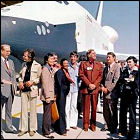 On schedule, the Space Shuttle Enterprise is rolled out of the Rockwell International plant in Palmdale, California to much public fanfare, a ceremony including Star Trek creator Gene Roddenberry and most of the cast who played the crew of the Enterprise’s fictional namesake (William Shatner was conspicuously absent). The timing of the rollout, ironically, was intended to roll the test shuttle – originally named Constitution – out of the hangar on Constitution Day during the bicentennial year.
On schedule, the Space Shuttle Enterprise is rolled out of the Rockwell International plant in Palmdale, California to much public fanfare, a ceremony including Star Trek creator Gene Roddenberry and most of the cast who played the crew of the Enterprise’s fictional namesake (William Shatner was conspicuously absent). The timing of the rollout, ironically, was intended to roll the test shuttle – originally named Constitution – out of the hangar on Constitution Day during the bicentennial year.
Soyuz 22
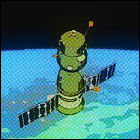 The Soviet Union launches Soyuz 22, a vehicle originally built as a backup for the Apollo-Soyuz Test Project. Unusually, the vehicle does not dock at the recently-launched Salyut 5 space station, but is instead placed in an unusual orbit that happens to make it easy to monitor a major NATO exercise near Norway. Cosmonauts Valery Bykovsky and Vladimir Aksyonov remain in that orbit for nearly eight days before returning to Earth.
The Soviet Union launches Soyuz 22, a vehicle originally built as a backup for the Apollo-Soyuz Test Project. Unusually, the vehicle does not dock at the recently-launched Salyut 5 space station, but is instead placed in an unusual orbit that happens to make it easy to monitor a major NATO exercise near Norway. Cosmonauts Valery Bykovsky and Vladimir Aksyonov remain in that orbit for nearly eight days before returning to Earth.
Abandon ship!: Soyuz 21’s hasty return
 42 days into their stay aboard the military space station Salyut 5, Soviet cosmonauts Boris Volynov and Vitaly Zholobov report unusual odors in the station’s air. On the 49th day of their stay, the two men bundle into their Soyuz 21 capsule to return home on only 10 hours’ notice, an unprecedented event. Details of the causes of the emergency return remain closely guarded to this day, including the possibility of toxic gas escaping into the station’s atmosphere and causing one or both cosmonauts to suffer rapidly deteriorating health. Neither of them fly in space again after their return.
42 days into their stay aboard the military space station Salyut 5, Soviet cosmonauts Boris Volynov and Vitaly Zholobov report unusual odors in the station’s air. On the 49th day of their stay, the two men bundle into their Soyuz 21 capsule to return home on only 10 hours’ notice, an unprecedented event. Details of the causes of the emergency return remain closely guarded to this day, including the possibility of toxic gas escaping into the station’s atmosphere and causing one or both cosmonauts to suffer rapidly deteriorating health. Neither of them fly in space again after their return.
Soyuz 21
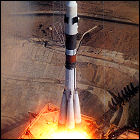 The Soviet Union launches cosmonauts Boris Volynov and Vitaly Zholobov aboard Soyuz 21, the first mission to the newly-orbited Salyut 5 military space station. Though a few scientific experiments are conducted, most of the crew’s activities involve military surveillance of Earth. The crew’s stay is intended to last as long as two months, though an emergency aboard the station will cut that stay short.
The Soviet Union launches cosmonauts Boris Volynov and Vitaly Zholobov aboard Soyuz 21, the first mission to the newly-orbited Salyut 5 military space station. Though a few scientific experiments are conducted, most of the crew’s activities involve military surveillance of Earth. The crew’s stay is intended to last as long as two months, though an emergency aboard the station will cut that stay short.